OpenStack has become a popular way to provide automated, on-demand, self-service Infrastructure as...
IT at Lightspeed: Impacts of the Digital Transformation
How Software is Increasing the Speed and Capacity to Deliver New Technology Capabilities
Digital Transformation is a Vast Topic—But What Does It Really Mean for IT?
Digital transformation has become a loaded topic; it’s been taking place for well over a decade (some would argue two), but the technology realm has given it a name and made it a primary topic of discussion exceedingly within recent years. Digital transformation has been reduced to a buzzword, and it’s become easy to disassociate it from what it truly means, how it’s impacting information technology, and by extension, how business is done.
If we were to boil it down, Marc Andreessen said it best: “…software is eating the world.” What digital transformation comes down to in consideration of IT is the fact that there is progressively less reliance on the technical specifics of hardware, and concurrently, more reliance on software and the capabilities you can gain from it—this is the instrument that is truly making a difference in technology and business operations.
Here’s what’s really happening: software is enabling a total transformation of technology and bringing disruption to every industry (“digital transformation”) because IT now has the power to do things that simply weren’t possible without hardware in the past. Virtually every business is going from a world of data centers that relied on the performance of hardware, servers, storage, and networking gear, to a world where the specifics of hardware are irrelevant and software is determining new technology capabilities.
55% of decision makers heading up digital transformation initiatives say that “evolving customer behaviors and preferences” are the main impetus for their projects.
-The 2016 State of Digital Transformation, Altimeter Group
Benefits Enterprises and Federal Agencies Can Expect to Gain from a Software-Dominant Approach
Software has extended itself into every aspect of IT. We can now virtualize compute, storage, networks, and even backups. Hardware has essentially become a commodity resource. Plus, we’re less compelled to worry about the hardware itself, or the vendor it comes from.
As a result of digital transformation, IT is delivering new functionalities, capabilities, features, and performance, all in a shorter time span. The major enablers are infrastructure as a service (IaaS), platform as a service (PaaS), and container as a service (CaaS)—these “as a service” features bring new abilities and ways of doing development and delivering software in a more agile, integrative way.
Ultimately, the digital transformation is delivering numerous tangible benefits to information technology, particularly:
- Increased ability to deliver new capabilities faster, thanks to software speed, rather than relying on hardware. Changes can be made, implemented, and pushed out practically instantly.
- Greater modernization and higher frequency of deployment through continuous integration and delivery (CI/CD).
- Faster time to repair, as software fixes can be executed more efficiently than hardware or even firmware changes.
Top 4 Key Priorities of Businesses Focused On Digital Transformation
As organizations are seeking to speed up their own digital transformations to gain enhanced innovation, production, and revenue, decision makers must place particular attention on four key areas of IT, according to VMware:
- Security transformation
Within a digitalized business, IT has to find a way to secure communications between users, applications, and data, and it’s not an easy feat. The best way to do so is by adding a software layer across endpoints and application infrastructure. Application infrastructure can be protected via network virtualization and micro-segmentation within the data center. Intrusion prevention, next-generation firewalls, and antivirus can all be integrated into the virtualization layer.
- Data center modernization
The software-defined data center is the way forward to modernization. Compute, storage, and networking can and should be controlled through software to maximize efficiency and agility. The ultimate results are faster deployment and simplified management.
- Public cloud integration (effectively Hybrid-Cloud)
67% of enterprise customers foresee an ideal future state in which they depend on multiple clouds.
-VMware Inner Circle Survey. May 2016.
Continued cloud adoption is no surprise; clouds are a speedy alternative to manually procuring IT infrastructure and services. Yet, enterprises do have to consider the potential issues of vendor lock-in and silos—there needs to be a way to scalably integrate public clouds from one place so that IT, developers, and engineers can operate, manage, and secure any application via any cloud. Enterprises must also consider the long term cost comparison when adopting public cloud, thereby shifting capital expenses (CAPEX) for hardware/software refresh to operational expenses (OPEX) for using public cloud resources.
- Digital workspace empowerment
Both cloud integration and the software-defined data center enable an excellent environment for the digitally empowered end user—but the need for mobility is moving faster than businesses can integrate it. By simplifying application access and consolidating endpoint management, IT has a real opportunity to reduce costs and maximize time and resources by offering a digital workspace to end users.
At August Schell, emerging technologies are a key practice area, and staying one step ahead of global digital transformation is no exception. If your agency or business is interested in discovering how software-defining your data center or implementing a DevOps container strategy, IT automation or virtual networking and security can enhance your security posture and optimize business processes, contact an August Schell specialist, or call us at (301)-838-9470.


